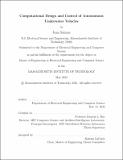| dc.contributor.advisor | Rus, Daniela L. | |
| dc.contributor.author | Salazar, Juan | |
| dc.date.accessioned | 2022-08-29T16:32:52Z | |
| dc.date.available | 2022-08-29T16:32:52Z | |
| dc.date.issued | 2022-05 | |
| dc.date.submitted | 2022-05-27T16:18:39.454Z | |
| dc.identifier.uri | https://hdl.handle.net/1721.1/145100 | |
| dc.description.abstract | Design of autonomous underwater vehicles (AUVs) currently relies heavily on rule-ofthumb techniques shared among those in the field, with many designs ending up with thousands of custom-made components that are not readily transferable to other designs made for different tasks. This is largely because of the complexity of designing a vehicle subject to the harsh ocean environment, which results in many interdepencies across design parameters. For the past few years, we have been developing hardware and software for SoFi, an autonomous soft robotic fish platform originally developed at MIT. Throughout our development process, we encountered a number of hardware-related obstacles concerning SoFi’s many custom components, which considerably slowed down our design iteration cycle. Using an automated pipeline that can synthesize designs from a pre-defined component library relieves the design cycle from the drawbacks of rules-of-thumb and highly customized components, and enables fast computational generation and evaluation of optimal performance underwater vehicles. In this work, we first describe our design work and evaluation on the SoFi platform. Next, we present an approach in the form of a automatic graph grammarbased AUV design framework that produces locally optimal AUV designs (including structure and control) based on a task specification. Our framework randomly samples the space of AUV topologies defined by the graph grammar and simultaneously optimizes structure and control with a gradient-based method using a differentiable simulator. Finally, we summarize the results from evaluating our autonomous soft robotic platform, the results from running our AUV design framework on a simulated mission and then show that the design framework carries massive potential in accelerating the future design of SoFi and other types of AUVs, conventional or non-conventional. | |
| dc.publisher | Massachusetts Institute of Technology | |
| dc.rights | In Copyright - Educational Use Permitted | |
| dc.rights | Copyright MIT | |
| dc.rights.uri | http://rightsstatements.org/page/InC-EDU/1.0/ | |
| dc.title | Computational Design and Control of Autonomous Underwater Vehicles | |
| dc.type | Thesis | |
| dc.description.degree | M.Eng. | |
| dc.contributor.department | Massachusetts Institute of Technology. Department of Electrical Engineering and Computer Science | |
| mit.thesis.degree | Master | |
| thesis.degree.name | Master of Engineering in Electrical Engineering and Computer Science | |
